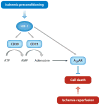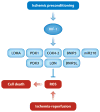Hypoxia-inducible factor 1 and cardiovascular disease
- PMID: 23988176
- PMCID: PMC4696033
- DOI: 10.1146/annurev-physiol-021113-170322
Hypoxia-inducible factor 1 and cardiovascular disease
Abstract
Cardiac function is required for blood circulation and systemic oxygen delivery. However, the heart has intrinsic oxygen demands that must be met to maintain effective contractility. Hypoxia-inducible factor 1 (HIF-1) is a transcription factor that functions as a master regulator of oxygen homeostasis in all metazoan species. HIF-1 controls oxygen delivery, by regulating angiogenesis and vascular remodeling, and oxygen utilization, by regulating glucose metabolism and redox homeostasis. Analysis of animal models suggests that by activation of these homeostatic mechanisms, HIF-1 plays a critical protective role in the pathophysiology of ischemic heart disease and pressure-overload heart failure.
Figures





References
-
- Wang GL, Semenza GL. Purification and characterization of hypoxia-inducible factor 1. J Biol Chem. 1995;270:1230–37. - PubMed
-
- Compernolle V, Brusselmans K, Franco D, Moorman A, Dewerchin M, et al. Cardia bifida, defective heart development and abnormal neural crest migration in embryos lacking hypoxia-inducible factor-1α. Cardiovasc Res. 2003;60:569–79. - PubMed
-
- Yoon D, Pastore YD, Divoky V, Liu E, Mlodnicka AE, et al. Hypoxia-inducible factor 1 deficiency results in dysregulated erythropoiesis signaling and iron homeostasis in mouse development. J Biol Chem. 2006;281:25703–11. - PubMed
Publication types
MeSH terms
Substances
Grants and funding
LinkOut - more resources
Full Text Sources
Other Literature Sources
Miscellaneous

